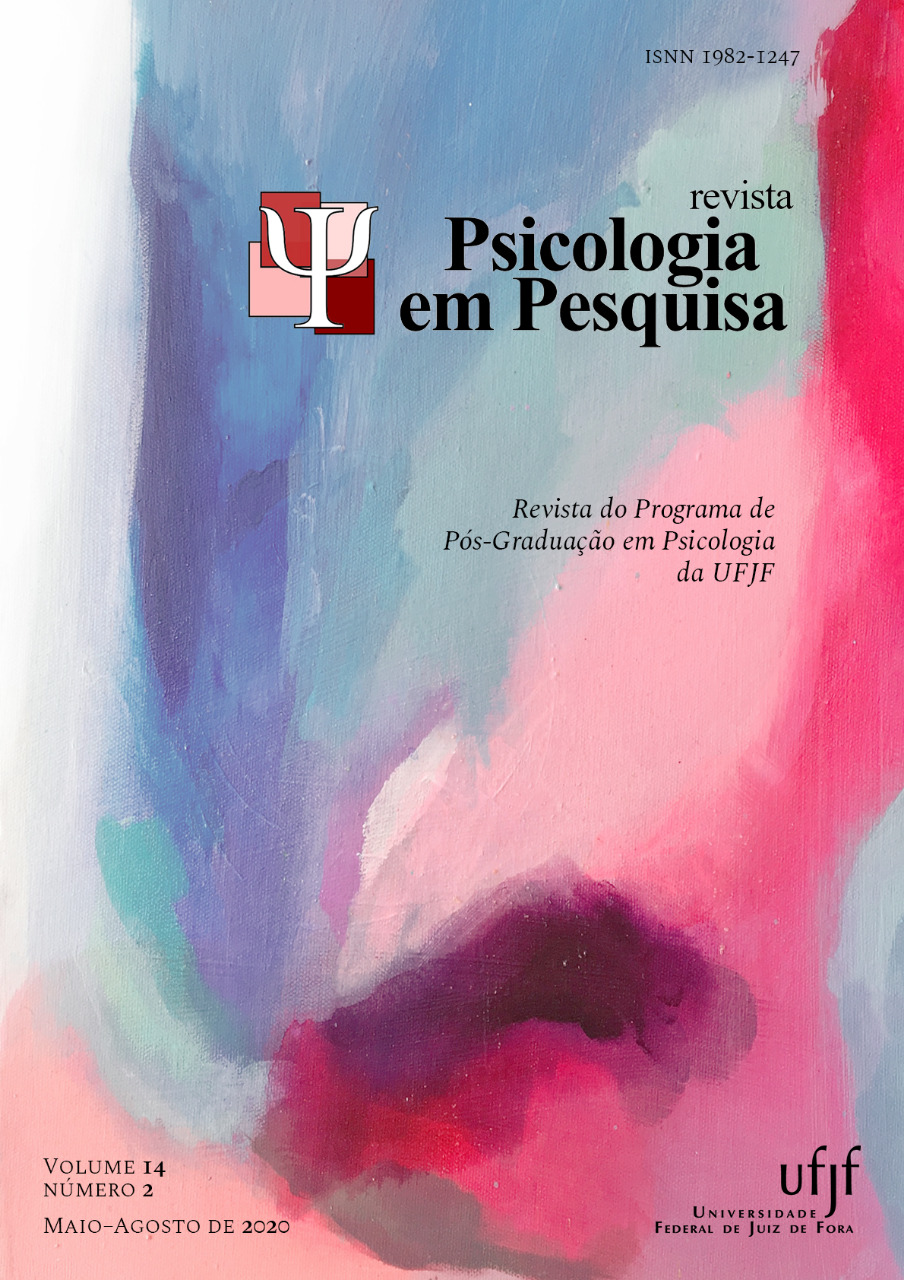¿Cómo delimitar y describir un sistema de Memoria Humana?
DOI:
https://doi.org/10.34019/1982-1247.2020.v14.27752Palabras clave:
Psicología cognitiva, Psicología experimental, MemoriaResumen
El estudiante o investigador que comienza sus estudios en Psicología Cognitiva generalmente aprende sobre el funcionamiento de varios sistemas de memoria (por ejemplo, memoria declarativa/explícita y memoria no-declarativa/implícita, memoria episódica, memoria semántica, memoria operativa/ de trabajo, memoria de procedimiento), pero no tiene acceso a los detalles del proceso científico de descripción de esos sistemas. Del mismo modo, los psicólogos clínicos pueden enfrentar dificultades para comprender los detalles metodológicos de los estudios que originaron los instrumentos de evaluación e intervención neuropsicológica mientras consultan la literatura científica del campo. El objetivo de este trabajo es presentar una visión general de los desafíos teóricos y metodológicos en el estudio de la memoria humana, con énfasis en la delimitación de los sistemas de memoria.
Descargas
Citas
Bunge, M. (1998). Philosophy of science: from explanation to justification (Vol. 1). New Brunswick, NJ: Transaction Publishers.
Atkinson, R. C., & Shiffrin, R. M. (1968). Human Memory: A Proposed System and its Control Processes. In K. W. Spence & J. T. Spence (Eds.), The psychology of learning and motivation: II (pp. 89–195). Oxford: Academic Press. https://doi.org/10.1016/S0079-7421(08)60422-3
Baddeley, A. D., & Hitch, G. (1974). Working Memory. In Psychology of Learning and Motivation - Advances in Research and Theory (Vol. 8, pp. 47–89). Academic Press. https://doi.org/10.1016/S0079-7421(08)60452-1
Barrouillet, P., & Camos, V. (2012). As time goes by: temporal constraints in working memory. Current Directions in Psychological Science, 21(6), 413–419. https://doi.org/10.1177/0963721412459513
Campoy, G., Castellà, J., Provencio, V., Hitch, G. J., & Baddeley, A. D. (2015). Automatic semantic encoding in verbal short-term memory: Evidence from the concreteness effect. Quarterly Journal of Experimental Psychology, 68(4), 759–778. https://doi.org/10.1080/17470218.2014.966248
Cochran, K. J., Greenspan, R. L., Bogart, D. F., & Loftus, E. F. (2016). Memory blindness: Altered memory reports lead to distortion in eyewitness memory. Memory & Cognition, 44(5), 717–726. https://doi.org/10.3758/s13421-016-0594-y
Cohen, N. J., Poldrack, R. A., & Eichenbaum, H. (1997). Memory for Items and Memory for Relations in the Procedural/Declarative Memory Framework. Memory, 5(1–2), 131–178. https://doi.org/10.1080/741941149
Cowan, N. (1993). Activation, attention, and short-term memory. Memory & Cognition, 21(2), 162–167. https://doi.org/10.3758/BF03202728
Denis, M., & Kosslyn, S. M. (1999). Scanning visual mental images: A window on the mind. Cahiers de Psychologie Cognitive/Current Psychology of Cognition, 18(4), 409–465.
Ebbinghaus, H. (1885). Memory: A Contribution to Experimental Psychology. Retrieved from http://nwkpsych.rutgers.edu/~jose/courses/578_mem_learn/2012/readings/Ebbinghaus_1885.pdf
Eysenck, M. W., & Keane, M. T. (2017). Manual de Psicologia Cognitiva (7ª ed.). Porto Alegre: Artmed.
Logie, R. H. (2003). Spatial and Visual Working Memory: A Mental Workspace. Psychology of Learning and Motivation - Advances in Research and Theory, 42, 37–78. https://doi.org/10.1016/S0079-7421(03)01002-8
Logie, R. H. (2011). The functional organization and capacity limits of working memory. Current Directions in Psychological Science, 20(4), 240–245. https://doi.org/10.1177/0963721411415340
Nadel, L., & Moscovitch, M. (1997). Memory consolidation, retrograde amnesia and the hippocampal complex. Current Opinion in Neurobiology, 7(2), 217–227. https://doi.org/10.1016/S0959-4388(97)80010-4
Narimoto, T., Matsuura, N., & Hiratani, M. (2018). Impaired Visuospatial Short-Term Memory in Children with ADHD. Journal of Genetic Psychology, 179(1), 19–29. https://doi.org/10.1080/00221325.2017.1414028
Neisser, U. (1967). Cognitive psychology. East Norwalk, CT, US: Appleton-Century-Crofts.
Pearson, D. G. (2001). Imagery and the visuo-spatial sketchpad. In J. Andrade (Ed.), Working memory in perspective (pp. 33–59). Hove: Psychology Press.
Posner, M. I. (1967). Short term memory systems in human information processing. Acta Psychologica, 27, 267–284. https://doi.org/10.1016/0001-6918(67)90069-8
Pylyshyn, Z. (2003). Return of the mental image: are there really pictures in the brain? Trends in Cognitive Sciences, 7(3), 113–118. https://doi.org/10.1016/S1364-6613(03)00003-2
Pylyshyn, Z. W. (1973). What the mind’s eye tells the mind’s brain: A critique of mental imagery. Psychological Bulletin, 80(1), 1–24. https://doi.org/10.1037/h0034650
Russell, W. A., & Storms, L. H. (1955). Implicit verbal chaining in paired-associate learning. Journal of Experimental Psychology, 49(4), 287-293. http://dx.doi.org/10.1037/h0042642
Schacter, D. L., & Tulving, E. (1994). What are the memory systems of 1994? In D. L. Schacter & E. Tulving (Eds.), Memory systems (pp. 1–38). Cambridge, MA, US: The MIT Press.
Shneider, A. M. (2009). Four stages of a scientific discipline; four types of scientist. Trends in Biochemical Sciences, 34(5), 217–223. https://doi.org/10.1016/j.tibs.2009.02.002
Simon, H. A. (1978). Information-processing theory of human problem solving. In W. K. Estes (Ed.) Handbook of learning and cognitive processes: human information processing (pp. 271-295). Hove: Psychology Press
Simon, H. A., & Feigenbaum, E. A. (1964). An information-processing theory of some effects of similarity, familiarization, and meaningfulness in verbal learning. Journal of Verbal Learning and Verbal Behavior, 3(5), 385–396. https://doi.org/10.1016/S0022-5371(64)80007-4
Sperling, G. (1960). The information available in brief visual presentations. Psychological Monographs: General and Applied, 74(11), 1–29. https://doi.org/10.1037/h0093759
Squire, L. R. (2009). Memory and brain systems: 1969-2009. The Journal of Neuroscience : The Official Journal of the Society for Neuroscience, 29(41), 12711–12716. https://doi.org/10.1523/JNEUROSCI.3575-09.2009
Squire, L. R., & Dede, A. J. O. (2015). Conscious and unconscious memory systems. Cold Spring Harbor Perspectives in Biology, 7(3), a021667. https://doi.org/10.1101/cshperspect.a021667
Sternberg, R. J., & Sternberg, K. (2017). Psicologia Cognitiva (7ª ed.). São Paulo: Cengage Learning.
St. Jacques, P. L., Szpunar, K. K., & Schacter, D. L. (2017). Shifting visual perspective during retrieval shapes autobiographical memories. NeuroImage, 148, 103–114. https://doi.org/10.1016/J.NEUROIMAGE.2016.12.028
Tulving, E. (1995). Organization of memory: Quo vadis? In M. S. Gazzaniga (Ed.), The cognitive neurosciences (pp. 839–853). Cambridge, MA, US: The MIT Press.
Tulving, Endel. (1985). How many memory systems are there? American Psychologist, 40(4), 385–398. https://doi.org/10.1037/0003-066X.40.4.385
Turvey, M. T. (1977). Contrasting operations to the theory of visual information processing. Psychologival Review, 84(1), 67–88. Retrieved from http://www.haskins.yale.edu/Reprints/HL0208.pdf
Uittenhove, K., Chaabi, L., Camos, V., & Barrouillet, P. (2019). Is Working Memory Storage Intrinsically Domain- Specific? Journal of Experimental Psychology: General. https://doi.org/10.1037/xge0000566
Unsworth, N., & Engle, R. W. (2007). The Nature of Individual Differences in Working Memory Capacity: Active Maintenance in Primary Memory and Controlled Search From Secondary Memory. https://doi.org/10.1037/0033-295X.114.1.104
Vasques, R., Garcia, R. B., & Galera, C. (2016). Short-term memory recall of visual patterns under static and dynamic visual noise. Psychology & Neuroscience, 9(1), 46–53. https://doi.org/10.1037/pne0000039















